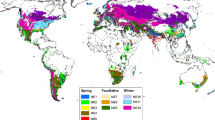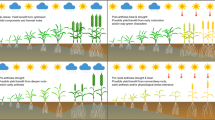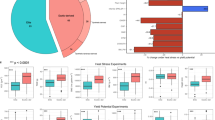Abstract
Plant breeding has been successful in adapting crops worldwide with one of the latest challenges being adaption to warmer days and nights. Taking wheat as a case study, here we show current elite nurseries express a range of levels of heat adaptation. Generally, the higher the selection ratio for yield response under warming, the less stable the yield response across environments. Specifically, less than one-third of genotypes trialled adapted well to the 0.26 °C warming of the last decade, and the phenotypes were stable in only 26% of environments. With continued warming, selection ratio falls 8.5% and stability falls 8.7% for each 1 °C increase in local temperature. Overall, faced with more climate variability, breeders need to revisit their breeding strategies to integrate genetic diversity that confers climate resilience without penalties to productivity in favourable seasons.




Similar content being viewed by others
Data availability
The original IWIN nursery data are publicly available at https://data.cimmyt.org. The climate data for historical period (1980–2021) are from the European Centre for Medium-Range Weather Forecast (https://www.ecmwf.int)—AgERA5 gridded weather dataset. The projected climate data for 2015–2100 generated by five Global Climate Models are from the Inter-Sectoral Impact Model Intercomparison Project (https://www.isimip.org). The cleaned nursery data and corresponding climate and environmental variables prepared for this study are available at https://doi.org/10.7910/DVN/3GAKGY (ref. 53).
Code availability
Data analysis scripts, including random forest (RF) yield and G × E forecasting and plotting, were developed with Python v3.11.4 and deposited in Harvard Dataverse at https://doi.org/10.7910/DVN/3GAKGY (ref. 53). Requests for scripts for the analyses performed can be directed to W.X.
References
Wheeler, T. & Braun, J. V. Climate change impacts on global food security. Science 341, 508–513 (2013).
Bentley, A. R. et al. Near- to long-term measures to stabilize global wheat supplies and food security. Nat. Food 3, 486–486 (2022).
Liu, B. et al. Similar estimates of temperature impacts on global wheat yield by three independent methods. Nat. Clim. Change 6, 1130–1137 (2016).
Zhao, C. et al. Temperature increase reduces global yields of major crops in four independent estimates. Proc. Natl Acad. Sci. USA 114, 9326–9331 (2017).
Deryng, D., Conway, D., Ramankutty, N., Price, J. & Warren, R. Global crop yield response to extreme heat stress under multiple climate change futures. Environ. Res. Lett. 9, 034011 (2014).
Deutsh, C. A. et al. Increase in crop losses to insect pests in a warming climate. Science 361, 916–919 (2018).
Guarin, J. R. et al. Evidence for increasing global wheat yield potential. Environ. Res. Lett. 7, 124045 (2022).
Reynolds, M. P. et al. Achieving yield gains in wheat. Plant Cell Environ. 35, 1799–1823 (2012).
Bloomfield, B. A., Rose, T. J. & King, G. J. Sustainable harvest: managing plasticity for resilient crops. Plant Biotechnol. J. 12, 517–533 (2014).
Reynolds, M. P. et al. in Advances in Wheat Genetics: From Genome to Field (eds Ogihara, Y. et al.) 355–368 (Springer Tokyo, 2015).
Byerlle, D. & Lynam, J. K. The development of the international center model for agricultural research: a prehistory of the CGIAR. World Dev. 135, 105080 (2020).
Reynolds, M. P. et al. Improving global integration of crop research. Science 357, 359–360 (2017).
Cossani, C. M. & Reynolds, M. P. Physiological traits for improving heat tolerance in wheat. Plant Physiol. 160, 1710–1718 (2012).
Hunt, J. R. et al. Early sowing systems can boost Australian wheat yield despite recent climate change. Nat. Clim. Change 9, 244–247 (2019).
Toreti, A. et al. Narrowing uncertainties in the effects of elevated CO2 on crops. Nat. Food 1, 775–782 (2020).
IPCC Climate Change 2021: The Physical Science Basis (eds Masson-Delmotte, V. P. et al) (Cambridge Univ. Press, 2021).
Helman, D. & Bonfil, D. J. Six decades of warming and drought in the world’s top wheat-producing countries offset the benefits of risking CO2 to yield. Sci. Rep. 12, 7921 (2022).
Snowdon, R. J., Wittkop, B., Chen, T. & Stahl, A. Crop adaptation to climate change as a consequence of long-term breeding. Theor. Appl. Genet. 134, 1613–1623 (2021).
Hoffman, A. L., Kemanian, A. R. & Forest, C. E. Analysis of climate signals in the crop yield records of sub-Saharan Africa. Glob. Change Biol. 24, 143–157 (2018).
Zhang, T. et al. Climate change may outpace current wheat breeding yield improvements in North America. Nat. Commun. 13, 5591 (2022).
Tack, J., Barkely, A. & Nalley, L. L. Effect of warming temperatures on US wheat yields. Proc. Natl Acad. Sci. USA 112, 6931–6936 (2015).
Challinor, A. J. et al. Current warming will reduce yields unless maize breeding and seed systems adapt immediately. Nat. Clim. Change 6, 954–958 (2016).
Reynold, M. P. et al. Harnessing translational research in wheat for climate resilience. J. Exp. Bot. 72, 5134–5157 (2021).
Molero, G. et al. Exotic alleles contribute to heat tolerance in wheat under field conditions. Commun. Biol. 6, 21 (2023).
van Ginkel, M. & Ortiz, R. Cross the best with the best, and select the best: HELP in breeding selfing crops. Crop Sci. 58, 17–30 (2018).
Sukumaran, S., Krishna, H., Singh, K., Mottaleb, K. A. & Reynolds, M. Progress and prospects of developing climate resilient wheat in South Asia using modern pre-breeding methods. Curr. Genomics 22, 440–449 (2021).
Reynolds, M. P. et al. Strategic crossing of biomass and harvest index—source and sink—achieves genetic gains in wheat. Euphytica 213, 527 (2017).
Pinto, R. S. & Rynolds, M. P. Common genetic basis for canopy temperature depression under heat and drought stress associated with optimized root distribution in bread wheat. Theor. Appl. Genet. 128, 575–585 (2015).
Reynolds, M. P., Sukumaran, S., Pinto, F. & Molero, G. Physiological Breeding for Climate Change. Population, Agriculture, and Biodiversity: Problems and Prospects (University of Missouri Press, 2020).
Hays, D. B., Barrios-Perez, I. & Camarillo-Castillo, F. in Wheat Improvement Food Security in a Changing Climate (eds Reynolds, M. P. & Braun, H.) 397–415 (Springer/CIMMYT, 2022).
Saint Pierre, C., Trethowan, R. & Reynolds, M. P. Stem solidness and its relationship to water-soluble carbohydrates: association with wheat yield under water deficit. Funct. Plant Biol. 37, 166–174 (2010).
Hays, D. B., Do, J. H., Mason, R. E., Morgan, G. & Finlayson, S. A. Heat stress induced ethylene production in developing wheat grains induces kernel abortion and increased maturation in a susceptible cultivar. Plant Sci. 172, 1113–1123 (2007).
Ziska, L. H. et al. Food security and climate change: on the potential to adapt global crop production by active selection to rising atmospheric carbon dioxide. Proc. R. Soc. B 279, 4096–4105 (2012).
Ziska, L. H. Three-year field evaluation of early and late 20th century spring wheat cultivars to projected increases in atmospheric carbon dioxide. Field Crop Res. 108, 54–59 (2008).
International Food Policy Research Institute. Global Spatially-Disaggregated Crop Production Statistics Data for 2000 Version 3.0.7. Harvard Dataverse https://doi.org/10.7910/DVN/A50I2T (2019).
Xiong, W. et al. Increased ranking change in wheat breeding under climate change. Nat. Plants 9, 1207–1212 (2021).
Sharma, R. C. et al. Genetic gains for grain yield in CIMMYT spring bred wheat across international environment. Crop Sci. 52, 1522–1533 (2012).
Boehm, J. D., Itria Ibba, J. M., Kiszonas, A. M. & Morris, C. F. End-use quality of CIMMYT-derived soft kernel durum wheat germplasm. II. Dough strength and pan bread quality. Crop Sci. 57, 1485–1494 (2017).
Keser, M., Akin, B., Ozdemir, F., Bartolini, P. & Jeitani, A. International winter wheat nurseries data: facultative and winter wheat observation nurseries and international winter wheat yield trials for semi-arid and irrigated conditions. Data Brief 41, 107902 (2022).
Lillemo, M., van Ginkel, M., Trethowan, R. M., Hernandez, E. & Crossa, J. Differential adaptation of CIMMYT bread wheat to global high temperature environments. Crop Sci. 45, 2443–2453 (2005).
Manes, Y. et al. Genetic yield gains of the CIMMYT international semi-arid wheat yield trials from 1994 to 2010. Crop Sci. 52, 1543–1552 (2012).
Boogaard, H. & van der Grijn, G. Data Stream 2: AgERA5 Historic and Near Real Time Forcing Data, Product User Guide and Specification (ed. ECMWF) (Wageningen Environmental Research, 2020).
Thorarinsdottir, J. T., Sillmann, L., Haugen, M., Gissbl, N. & Sandstad, M. Evaluation of CMIP5 and CMIP6 simulations of historical surface air temperature extremes using proper evaluation methods. Environ. Res. Lett. 15, 124041 (2020).
Hersbach, H. et al. The ERA5 global reanalysis. Quart. J. Roy. Meteor. Soc. 146, 1999–2049 (2020).
Gleixner, S., Demissie, T. & Diro, G. T. Did ERA5 improve temperature and precipitation reanalysis over East Africa? Atmosphere 11, 996 (2020).
O’Neill, B. C. et al. The scenario model intercomparison project (ScenarioMIP) for CMIP6. Geosci. Model Dev. 9, 3461–3482 (2016).
Lange, S. ISIMIP2b Bias-Correction Fact Sheet (ISIMIP, 2018).
Gourdji, S. M., Mathews, K. L., Reynolds, M., Crossa, J. & Loball, D. B. An assessment of wheat yield sensitivity and breeding gains in hot environments. Proc. R. Soc. B. 2018, 20122190 (2012).
Allard, R. W. Principles of Plant Breeding 2nd edn (John Wiley & Sons, 2019).
Breiman, I. Random Forests. Math. Learn. 45, 5–32 (2001).
Amthor, J. S. Effects of atmospheric CO2 concentration on wheat yield: review of results from experiments using various approaches to control CO2 concentration. Field Crops Res. 73, 1–34 (2001).
Kimball, B. A. Crop responses to elevated CO2 and interactions with H2O, N, and temperature. Curr. Opin. Plant Biol. 31, 36–43 (2016).
Xiong, W. Clean and formatted IWIN wheat breeding trial data. Version 2. Harvard Dataverse https://doi.org/10.7910/DVN/3GAKGY (2024).
Acknowledgements
This work was supported by the project granted by the Foundation for Food and Agriculture Research (FFAR). This study was also supported by the CGIAR research programme on wheat agri-food systems (CRP WHEAT) and the CGIAR Platform for Big Data in Agriculture.
Author information
Authors and Affiliations
Contributions
W.X. and M.P.R. conceived the study. C.M., B.A., K.M., F.O. and Z.H. collected and processed the data. W.X. and J.C. analysed the data. W.X. and M.P.R. wrote the paper, and all contributed to the writing.
Corresponding authors
Ethics declarations
Competing interests
The authors declare no competing interests.
Peer review
Peer review information
Nature Climate Change thanks Nimai Senapati, Rod Snowdon and the other, anonymous, reviewer(s) for their contribution to the peer review of this work.
Additional information
Publisher’s note Springer Nature remains neutral with regard to jurisdictional claims in published maps and institutional affiliations.
Extended data
Extended Data Fig. 1 Illustration of the relationship between WA and SE and computing WAI and SEI.
Blue points indicate all possible pairs of WA and SE for the nursery, with boxplot at the top and right showing the value distribution of WA and SE, respectively. The vertical/horizontal lines in the box-and-whisker plots represent, from left/bottom to right/top, the minimum, 25th percentile, median, 75th percentile and maximum of the WAI/SEI figures. Grey area under the blue points illustrates all varying combinations of WA and SE that breeders can expect. The green square shows the centroid point of the grey area, computed by weighted-averaging all possible WA and SE, with estimated WAI and SEI denoting the mean potential of the nursery for selecting warming-adapted cultivars.
Extended Data Fig. 2 Value distribution of SEI (a) and WAI (b) across nurseries.
Each box-and-whisker summarizes the value distribution of SEI (a) or WAI (b) for all temperature increase levels, namely 0.26 °C (warming in 2011–2020), 1 °C, 2 °C, 3 °C, 4 °C, 5 °C and 6 °C. The horizontal lines in the box represent, from bottom to top, the minimum, 25th percentile, median, 75th percentile and maximum of the SEI/WAI figures. The black dashed lines between the boxes are median value of SEI/WAI for elite breeding programs (left) and the stress breeding programs (right).
Extended Data Fig. 3 Selection efficiency (SE%) and wide adaptation (WA%) of genotypes for different warming levels under a breeding strategy assumed to maintain crop phenology for future climate conditions.
(a) ESWYT, (b) IDYN, (c) IWWYT-IRR, (d) HTWYT, (e) SAWYT, (f) IWWYT_SA.
Extended Data Fig. 4 Selection efficiency (SE%) and wide adaptation (WA%) of genotypes for different warming levels under a breeding strategy assumed to yield radiation efficiency under higher CO2 concentrations.
(a) ESWYT, (b) IDYN, (c) IWWYT-IRR, (d) HTWYT, (e) SAWYT, (f) IWWYT_SA.
Extended Data Fig. 5 Comparison of rate of change in wide adaptation index (WAI) and selection efficiency index (SEI) among different breeding strategies at each nursery.
(a) The present breeding approach, (b) a breeding strategy to maintain crop phenology under climate change, (c) a breeding strategy to increase radiation efficiency under higher CO2 concentration, and (d) the present breeding approach as (a), but the computation follows steps described in the method except yearly yield is estimated from climate variables fitting by least absolute shrinkage and selection operator regression (see Methods). The height of bar represents the estimated rate of change of SEI and WAI, estimated from the estimated figure of SEI and WAI for the seven warming levels (colored points). The error bars show the 95% confidence interval of the estimated changing rate, and bar width indicating the relative value of SEI and WAI for the current warming level of 2011–2020 (0.26 °C).
Supplementary information
Supplementary Information
Supplementary Figs. 1–4 and Tables 1–3.
Rights and permissions
Springer Nature or its licensor (e.g. a society or other partner) holds exclusive rights to this article under a publishing agreement with the author(s) or other rightsholder(s); author self-archiving of the accepted manuscript version of this article is solely governed by the terms of such publishing agreement and applicable law.
About this article
Cite this article
Xiong, W., Reynolds, M.P., Montes, C. et al. New wheat breeding paradigms for a warming climate. Nat. Clim. Chang. 14, 869–875 (2024). https://doi.org/10.1038/s41558-024-02069-0
Received:
Accepted:
Published:
Issue Date:
DOI: https://doi.org/10.1038/s41558-024-02069-0
- Springer Nature Limited





